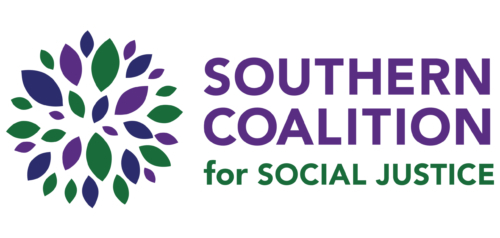Last month, the North Carolina Department of Public Safety’s Center for Safer Schools (CFSS) released its 2015 North Carolina School Resource Officer Census. The Census defines school resource officers (SROs) as “law enforcement officers who are assigned to work within the school setting.” (p. 2). It “provides a snapshot of SROs in North Carolina schools in the 2014-15 academic year.” (Cover). The stated goals of the Census were two-fold: 1) “to provide a clear picture of current SROs across the state;” and 2) “to help identify potential needs.” (p. 2).
Additional study of SROs in North Carolina is urgently needed. The last time data about SROs in the state was collected and published was six years because the Center for the Prevention of School Violence closed after the 2008-09 school year.
The number of SROs is rapidly increasing. The Census authors estimate that there are 1,000 SROs in North Carolina – an increased of over 300% since the first recorded baseline in 1995-96. (p. 3). (Note: The estimate of 1,000 SROs differs drastically from the 1,400 approximation provided by the CFSS in its 2014 Report to the Governor.)
Accordingly, an increasing amount of taxpayer money is being spent on SROs, despite decreasing funding for support staff (e.g., counselors, social workers, and psychologists) and other essential personnel and resources in public schools. Moreover, as the number of SROs has risen, so has the percentage of delinquency complaints that are school-based. During 2013-14, 45% of all delinquency complaints were school-based.
The 2014-15 Census provides some useful data, including the demographics and placements of SROs. It also generated the following positive responses to survey question number 27: “What would you offer that could improve the job of School Resource Officers statewide?”
- More SRO training, including on MOUs, bullying, disabilities, mental health issues, child psychology, and anger management (pp. 33, 35);
- More diversion programs (p. 36), alternative schools (p. 52), and other programs to help at risk youths (pp. 42, 51);
- No SRO’s in the elementary schools (p. 43); and
- Seasoned, mature SROs who view being an SRO as a calling and who are put through strict interviews pertaining to working with kids (p. 46).
However, the Census in-and-of-itself also has three major flaws. First, it omits key information. The survey had a low response rate given its target population. Less than one-third of the estimated total number of SROs responded at all. (p. 4). In 43% of school districts, no SROs responded. (p. 11). No charter school SROs responded to the survey. (p. 5). Twenty-four districts did not even respond to the CFSS’ request for the names and contact information for designated security personnel; therefore, SROs in those districts presumably could not be sent a survey. (p. 3).
Second, the Census omits critical information. It did not involve important stakeholders who have direct contact with SROs on a daily basis – i.e., students, parents, and school staff. Moreover, the Census does not provide any data about:
- The financial costs of SROs;
- SROs’ level of prior experience working with youth;
- Arrests and court referrals by SROs;
- Weapons carried by SROs;
- Uses of force by SROs;
- Individual schools or districts;
- SROs’ actual knowledge of MOU contents;
- Contents of MOUs; or
- Job satisfaction among SROs.
Third, the Census contains broad declarations without reference to research to support the statements. For example, the authors claim, without a source: “Students working in close proximity and interacting with an SRO begin to know and trust officers.” (p. 2); “The SRO not only provides a level of deterrence on the school campus,…” (p. 2); and “our elementary schools show a need for increased SRO coverage.” (p. 15).
The Census also provides troubling insights into school policing in the state. Among the SROs who responded to the survey:
- Lack of training: 43% had not received Crisis Intervention Team training (p. 4); 88% had not completed “Mental Health First Aid for Youth” training (p. 10); 18% had not completed “SRO Basic Training” (p. 9); 61% had not completed “advanced SRO Training” (p. 9); and there was no indication that any of the SROs who responded to the survey had training adolescent development, special education law, cultural competency, or implicit bias;
- Lack of diversity: 80% were male, compared to 51% of the student population (p. 5); and 77% were White, compared to 51% of the student population (p. 6);
- Lack of experience: 50% had been an SRO for three or fewer years (p. 8); and
- Lack of guidelines: 11% reported that their agency did not have a memorandum of understanding (MOU) with the school system and 13% reported being unsure if an MOU is in place (p. 13).
Finally, SROs provided disturbing answers to question number 27 (see above), such as calling for: SRO access to a long gun or rifle in the school (pp. 33, 35, 48, 51); “a permanent alternative school for kids who have committee certain offenses at school” (p. 42); and “All new schools [need to] be fenced in and have solid metal class room doors.” (p. 44)
Moving forward, the CFSS should work with a diverse group of stakeholders – including students, parents, school staff, Department of Public Instruction staff, prosecutors, defense attorneys, policymakers and lawmakers, and advocates – to design and conduct a more comprehensive, useful evaluation of SROs and to study nationwide best practices that can be adopted in North Carolina
Jason Langberg is on YJNC’s Board of Directors.
